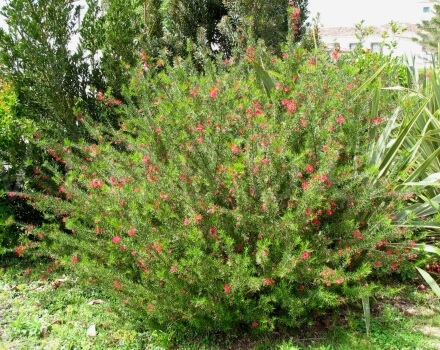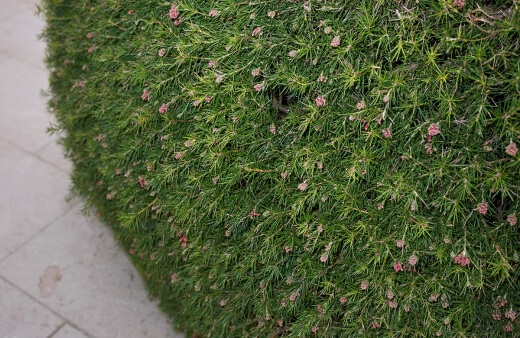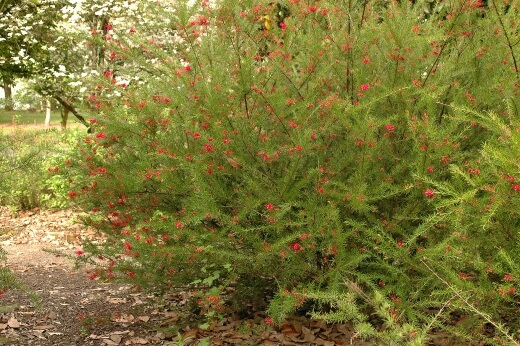Grevillea rosmarinifolia is a perky and highly popular native flowering shrub that produces ornate and spider-like pinkish-red flowers with cream accents. Thanks to its beautiful blooms and rounded growth habit, it is also one of the most cultivated grevilleas that can provide dense and bushy silvery-green, needle-like foliage, perfect for many applications in the garden.
Here is your guide to growing and caring for this sensational species of grevillea.
More...

Family: | Proteaceae |
|---|---|
Genus: | Grevillea |
Species: | G. rosmarinifolia |
Origin: | New South Wales and Victoria |
Common Names: | Rosemary grevillea |
Location: | Outdoor |
Type: | Shrub |
Growth: | Up to 2 metres tall and 1 metre wide |
Sun requirements: | Full sun to partial shade |
Foliage Colour: | Green |
Flower Colour: | Pink to red |
Flowering: | Late winter to spring |
Maintenance level: | Low |
Poisonous for pets: | Non-toxic to cats and dogs |
Introducing Grevillea rosmarinifolia
This hardy, evergreen shrub can add wonderful texture to outdoor spaces with its fine luminous green foliage on top of lively bursts of colour with its brilliant blooms. Enjoy a dense and compact growth habit and gorgeous clusters of long-lasting, eye-catching blooms.
Botanically labelled Grevillea rosmarinifolia, the plant is commonly known as the rosemary grevillea. It is part of the Proteaceae family and this species of grevillea is native to New South Wales and Victoria but is now naturalised in many parts of the country.
It thrives in temperate climates where very successful specimens can flower for most of the year, offering long-lasting beauty in gardens. This shrub is considered fast-growing, typically reaching up to 2 metres tall and 1 metre wide, but can be kept smaller if grown in containers.
As this native has adapted to many parts of the country, it can be grown in almost any garden and it will also help to support native creatures. The nectar-rich blooms alone will attract many local birds, bees, butterflies and other beneficial insects.
Here are some common uses for rosemary grevillea:
- Great for hedging
- Ideal for patio container gardening
- Will make for a wonderful feature if allowed to grow
- Great for general garden shrubbery or gap filling
How to Grow Grevillea rosmarinifolia
This species should be readily available at many Australian nurseries. Establishing a healthy nursery plant is the easiest way to grow your plant and it will also flower far sooner.
Alternatively, as with many grevilleas, this shrub can be propagated using cuttings. Firm cuttings should be taken from the current season's growth which usually strikes reliably.
Learn how to take cuttings by following our in-depth guide below:
Planting Conditions for Rosemary Grevillea

Source: Provincial Plants & Landscapes
Planting should ideally be done during or close to spring or autumn when temperatures are slightly more comfortable. These shrubs will perform best planted in temperate to warm gardens where they can be established in beds or patio containers.
Check out these stylish plant stands for some outdoor décor inspiration.


Get Your Free Guide:
Master Growing Australian Natives eBook
A Must Have Complete Guide for Every Australian Garden
Get Your Free Guide:
Master Growing Australian Natives eBook
A Must Have Complete Guide for Every Australian Garden
Best Soil
This plant can tolerate many soil types so long as the soil is well-draining and not too moist. Sandy soils can also work but may need some organic matter. Slightly acidic soils are preferred.
Sunlight Needs
As with most grevilleas, this species is also a sun-loving shrub. Planting in a position with full sun is ideal as it will ensure proper growth and bountiful blooms. Partly shaded positions can be tolerated but your plant may become leggy and develop fewer flowers the more shade it gets.
How to Care for Grevillea rosmarinifolia
These shrubs are frost hardy, able to withstand temperatures down to about -10°C. They are also tolerant to cold, wind and drought.
Watering Rosemary Grevillea
In your garden, try to water your grevillea about once a week. You don’t have to water too deep or for a long duration, just a good 10-minute soaking should be sufficient. Container-grown shrubs might need to be watered more frequently.
Proper Pruning
It is best to prune moderately but regularly, especially after flowering to maintain size and shape. Regular pruning will also ensure your shrub stays dense and doesn’t become leggy.
Looking for quality shears? Here are our recommended pruning shears for 2023.
Feeding
In spring, fertilise your shrub with blood and bone or a native plant fertiliser low in phosphorus.
Mulching
These shrubs love lots of leaf litter or coarse mulch around their roots, especially in summer to maintain a cooler environment.
General Tip
Try to be as careful as possible not to disturb the roots when handling this plant.
Pests, Problems and Diseases
Grevilleas rarely have any pest or disease issues of note as long as they are grown in well-draining soil, are not overwatered, and are fed with a fertiliser low in phosphorus.
Growing Grevillea rosmarinifolia as a Hedge
Picking hardy plants is always important when growing a hedge as there’s nothing worse than a hedge that has dead plants in it. Your initial selection will go a long way in avoiding this.
The great thing about Grevillea rosmarinifolia is that it can grow into a hedge that forms a formidable barrier. The secret is to not plant the plants too far apart and to also prune the side branches to increase branching to form the hedge that you are after.
I’ve seen examples of Grevillea rosmarinifolia growing in gardens as single specimens that have been left unpruned and as a result they send out long branches that make the plant look sparse. In my opinion this look is unattractive, so if you want a nice thick barrier then make sure you don’t plant too far apart and prune early.
One of the other traits about Grevillea rosmarinifolia is that it is a very variable plant. In nature it grows naturally over a varied group of areas so in cultivation you also get variation as well.
The variation not only consists of leaf and flower variation but also the size and growth rate of the plant. So having said that, you really need to be selective so you can ensure the Grevillea rosmarinifolia that you select does fit your requirements.
Another great trait of Grevillea rosmarinifolia, just as with most grevilleas, is that it does hybridise and as a result there are cultivars in the nurseries that would also be worth considering. Grevillea ‘Pink Pearl’ is one and Grevillea ‘Canberra Gem’ may also be worth looking at.
Grevillea rosmarinifolia is a great choice as a hedge. I suppose it will just come down to what’s available.
Grevillea rosmarinifolia Frequently Asked Questions

What is the longevity of rosemary grevillea?
Grevilleas are fast-growing shrubs that can live between 50 and 65 years in good conditions.
How close to plant Grevillea rosmarinifolia?
For hedging or screening purposes, plant these shrubs about 1.5 to 2 metres apart to give them enough space to spread and grow.
What is the best mulch for rosemary grevillea?
Overall, grevilleas are naturally water-wise plants. They benefit from a coarse grade mulch like pine bark mulch.
Be sure to check out our ultimate Grevillea guide for more information on these popular native shrubs as well as information on many of the most ornamental varieties to grow.
Add Native Spectacle to Your Garden with Grevillea rosmarinifolia
There’s a lot to love about this striking species of grevillea. Rosemary grevillea can impress throughout the year with its bright-green, fine-toothed foliage and its perky clusters of long-lasting vibrant pinkish-red blooms.
Offering a very practical dense and compact growth habit, this lovely native shrub can be used to decorate almost any garden in a variety of ways. Start growing your Grevillea rosmarinifolia and add some native spectacle to your outdoor spaces.
Published on April 8, 2023 by Nathan Schwartz
Last Updated on January 26, 2025





